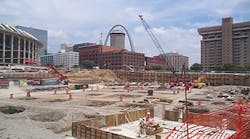Stunt planes soared into the sky, twirled in the air, and then disappeared into the distance. As the mercury rose to 93°, 30,000 baseball fans celebrated Fourth of July by cheering on their hometown team — the St. Louis Cardinals. In between innings, fans walked outside to hang over the balcony and observe the construction of the new Cardinals stadium, which is scheduled to open for the 2006 baseball season.
The $325 million stadium will replace the original Busch Stadium, which opened for the first game of the 1966 season against the Atlanta Braves. The construction team will build about 75% of the new ballpark on a parking lot south of the existing facility, but a quarter will overlap into the footprint of the existing stadium. Following the end of the 2005 baseball season, the original stadium will be demolished and crews will have to start working overtime to finish the facility prior to opening day. Workers will also begin backfilling the hole to create the Ballpark Village, a $60 million commercial and residential district featuring a 300,000-square-foot, seven-story office building, a 27,000-square-foot, two-story retail and office building, and a Cardinals museum.
The construction crew has a total of 27 months to get the stadium ready for the start of the 2006 season, but the lion's share of the work will take place between October 2005 and April 2006, says Joe Abernathy, vice president of operations for the St. Louis Cardinals. Opening day, however, won't signal the end of construction. From April through July 2006, the contractors will enter the third and final phase of the project, when they'll finish building the upper level of left field and install 5,000 additional seats to bring the new stadium to its full capacity.
“It's a complicated approach, but it's one that's necessary because of the proximity of the two structures and the fact that they overlap,” Abernathy says.
While contractors will soon be working double shifts, a small team is now on site to pour the concrete. Four electricians from Sachs Electric, a St. Louis-based electrical contracting firm, are roughing in the wiring and completing the grounding and in-slab work, but the company expects the number of electricians to peak at around 50 during the later stages of the project. Sachs won a contract for the underground distribution, site and stadium lighting, power distribution, fire alarm, and security systems as well as work in the concession stands, suites and sky boxes.
“Sachs has had a strong relationship with the Cardinals organization for 40 years, and our company is proud that it will continue that history with this next generation stadium,” says Rob Moeller, vice president of the technology/special projects sector for Sachs.
Sachs, which wired the original Busch Stadium, has been involved in the majority of the maintenance and renovation projects at the stadium over the years, including a new sports lighting system; new sound system; renovation of the luxury boxes; and the installation of three unit substations and soil warming cables in the playing field. But after four decades, the facility's electrical and mechanical systems are beginning to wear thin, says Ron White, senior designer for Sachs. While the old stadium wasn't equipped with a fire alarm or building automation system, the new facility will feature electrical and communications systems designed to meet the technological needs of the 21st century.
One of the most notable differences between the new and old stadiums, however, is that the new ballpark will be specifically designed for baseball. The original ballpark served as a multi-purpose stadium for both baseball and football until 1988, when the St. Louis Cardinals football team moved to Phoenix. Because the new stadium will only be used for baseball games, the seats will be positioned closer to the playing field, says Paul Mueller, senior project manager for Sachs. The stadium lights will also be specifically designed to illuminate the baseball diamond, and the stadium will feature a wider concourse.
“We will soon have a building that will be totally designed and coordinated for baseball from the way it's built to the way the power will be operated in the stadium,” Abernathy says. “Busch Stadium has lasted the longest of any of the multipurpose stadiums built in the 1960s. It will be sad to see Busch go because of its history, but we're excited to see what a new ballpark will bring to the city and fans of St. Louis.”



